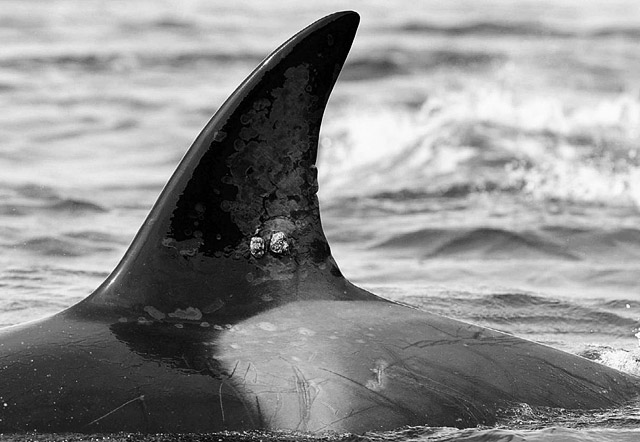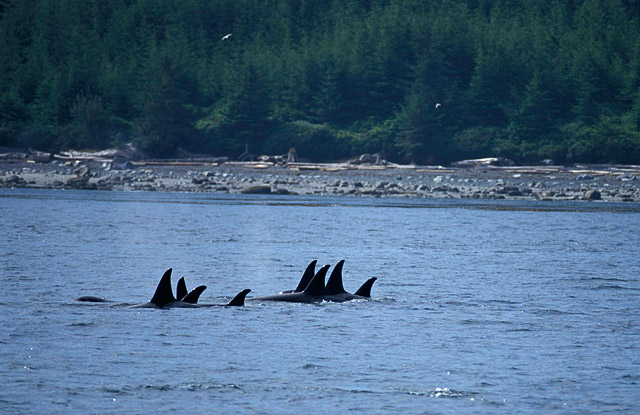|
| |
| 12. Februar 2012 |
Kanadisches Berufungsgericht bestätigt die Verurteilung des
Fischereiministeriums wegen unterlassener Schutzmaßnahmen für Orcas |
| |
| Bereits im Dezember 2010 hatte der kanadische Bundesgerichtshof in einem denkwürdigen Urteil das kanadische Fischereiministerium (Department of Fisheries and Oceans, DFO) dazu verklagt, bislang sträflich unterlassene Schutzmaßnahmen für die Orcapopulationen, die entlang der Küste von BC leben, zu ergreifen. Neun Umweltschutzorganisationen, u. a. die Raincoast Conservation Foundation, hatten zusammen mit der Organisation Ecojustice gegen das DFO geklagt, damit es endlich die gültigen kanadischen Umweltschutzgesetze einhält und die Lebensräume der Orcas zu schützen beginnt. Das Gericht gab den Umweltschutzorganisationen recht, fällte eine Grundsatzentscheidung für den Schutz gefährdeter oder vom Aussterben bedrohter Arten in Kanada und verteilte eine schallende Ohrfeige für die Untätigkeit des DFO. Es war schon peinlich genug, dass das Fischereiministerium auf Einhaltung kanadischer Umweltschutzgesetze verklagt werden musste, doch damit nicht genug: Das DFO ging im Januar 2011 in Berufung und versuchte hierdurch einer Verurteilung zu entgehen. Am 9. Februar 2012 wies das Berufungsgericht (Federal Court of Appeal) die fadenscheinigen Einwände des DFO endgültig zurück und verurteilte die Regierung zur Übernahme der Gerichtskosten. Das DFO hatte argumentiert, dass es im Fischereigesetz (Fisheries Act, Section 35) „Ermessensvorkehrungen“ zum Schutz kritischer Lebensräume gäbe und dass mehr nicht notwendig sei. Das kanadische Gesetz zum Schutz gefährdeter Arten hingegen (Species at Risk Act, SARA) schreibt diesen Schutz gesetzlich vor. Die Population der südlichen Orcas (southern residents) besteht nur noch aus 87 – 89 Tieren, die in drei Familienverbänden leben. Diese Population gilt bereits als vom Aussterben bedroht (endangered). Nach dem kanadischen Species at Risk Act (SARA) ist eine „endangered species … a wildlife species that is facing imminent extirpation or extinction“. Die Population der nördlichen Orcas (northern residents) umfasst noch etwa 220 Tiere und gilt als bedroht (threatened). Gemäß dem SARA ist eine „threatened species … a wildlife species that is likely to become an endangered species if nothing is done to reverse the factors leading to its extirpation or extinction“. |
| |
 |
| Drei Orcas (Orcinus orca) |
© Klaus Pommerenke |
|
| |
| In der Pressemitteilung von Ecojustice (www.ecojustice.ca) vom 9. Februar 2012 (Appeal court decision affirms protection for killer whales) werden die Hintergründe erläutert: „Ecojustice, representing a coalition of nine environmental groups, successfully argued in Federal Court last year that DFO had not met its legal obligation to protect killer whales. The court ruled that the Minister of Fisheries and Oceans must legally protect all aspects of killer whale critical habitat – including their food supply and the quality of their marine environment. DFO appealed that decision, claiming that discretionary provisions in the Fisheries Act adequately protect the critical habitat of aquatic species such as the killer whale. The Act however, does not make critical habitat protection mandatory, as is the case under the Species at Risk Act. Instead, the Fisheries Act gives Minister Keith Ashfield broad discretion to authorize activities that destroy habitat. ‚The original ruling, and now the Court of Appeal’s judgment, have confirmed that the fate of killer whales should not be left to the discretion of politicians‘, Venton said. ‚These whales must be protected by law. They need spaces to feed, breed and raise their young if their populations are going to survive and recover.‘ … Killer whales are considered a ‚sentinel species‘, which means their health is a bellwether for the overall health of the ocean environment in which they live. In his decision last year, Federal Court Justice James Russell held that DFO had failed to legally protect killer whale critical habitat and made 13 declarations that included: |
- DFO unlawfully relied on non-binding policies and guidelines, as well as government discretion, to protect habitat.
- DFO unlawfully limited the scope of legal protection to exclude biological elements of critical habitat.
- DFO has a legal obligation to protect the biological aspects of critical habitat, such as prey (food) availability and marine environment quality, through law.
|
| The victory was precedent-setting for the more than 90 endangered and threatened marine species listed under the Species at Risk Act, all of which depend on healthy habitats to survive.“ |
| Die jetzt nochmals bestätige Rechtsprechung zum Schutz kritischer Lebensräume für Orcas kann Konsequenzen haben für die Fischerei und den Schiffsverkehr in der Strait of Georgia und der Juan de Fuca Strait (kritischer Lebensraum der Southern Residents) und für die Queen Charlotte Strait und Johnstone Strait (kritischer Lebensraum der Northern Residents). Auch die Zunahme des Öltankerverkehrs von und nach Vancouver muss jetzt in die Schutzüberlegungen einbezogen werden. Vielleicht rückt auch die Gefährdung der weiter im Norden lebenden Orcas (in der Hecate Strait und Dixon Entrance) durch den geplanten Öltankerverkehr nach Kitimat etwas mehr ins Bewusstsein der Öffentlichkeit, falls das Enbridge Northern Gateway Pipeline-Projekt realisiert werden sollte. |
| Was eine Schutzstrategie für die Orcas und ein Programm zur Vermehrung der Restpopulation beinhalten soll, wird heftig umstritten sein. Dem globalen Problem der Verseuchung der Meere ist nur schwer beizukommen. In den langlebigen Orcas reichern sich Giftstoffe in extremem Maße an, schwächen das Immunsystem, die Orcas sind gestresst vom dauernden Unterwasserlärm des kaum zu verhindernden zunehmenden Schiffsverkehrs. Jetzt gibt es Pläne der United States National Oceanic and Atmospheric Administration (NOAA), einige der verbleibenden 87 oder 89 Southern Residents mit GPS-Sendern zu markieren, um etwas über ihre Aufenthaltsgebiete im Winter zu erfahren. Mit kanadischen Behörden sind diese Pläne leider nicht abgesprochen worden, sie stoßen z. T. auf heftigen Widerstand. „The nominal information that might be generated from deploying these invasive tags to the fins of endangered killer whales simply does not justify the risk of serious injury resulting from the tags“, erklärte Misty MacDuffee von der Raincoast Conservation Foundation (RCF). Auch Chris Darimont, Wissenschaftsdirektor der RCF und Spezialist für nicht-invasive Untersuchungstechniken von Wildtieren, hat schwere Bedenken: „We would all like to know more about the movement of killer whales, especially during winter, but these tags are unlikely to provide that information on their own … This is a small, exceptionally vulnerable population of whales where the loss of individuals from any ensuing infection could have broader implications.“ Noch ist unklar, ob die NOAA ihre Pläne, Orcas mit GPS-Sendern zu versehen, umsetzen wird. |
| |
 |
| Rückenfinne eines Transient Orcas nach dem Abscheuern eines angebrachten Senders (Aufnahme im Gebiet der Strait of Georgia). Man sieht zwei geschwürige Wunden, wo die Widerhaken des Senders saßen. |
© submitted, Times Colonist |
|
| |
| Weitere Hintergrundinformationen zu den bedrohten Orcas und dem Rechtsstreit finden Sie in der nachfolgend abgedruckten englischen Zusammenstellung von Ecojustice: |
| |
| „Basic killer whale facts: |
- Killer whales, also known as orcas, are top predators in the marine food web and are considered a ‚sentinel species’, meaning their health is an overall indicator of the ocean’s ecological health.
- This lawsuit is about two populations of resident killer whales found off British Columbia’s coastline: The northern residents (264 remaining) and the southern residents (87 – 89 remaining).
The Species at Risk Act (SARA) and critical habitat:
- SARA’s mandate is to protect vulnerable species and ensure they recover to healthy population levels.
- The act lists the southern residents as an endangered species and the northern residents as a threatened species.
- According to SARA, the government (in this case, the Department of Fisheries and Oceans) must legally protect the identified critical habitat of endangered and threatened species from destruction.
- SARA defines critical habitat as the habitat necessary for the survival or recovery of a listed wildlife species that is identified in a recovery strategy or action plan.
- The critical habitat of southern resident killer whales includes waters around the San Juan and Gulf Islands and into Georgia Strait; northern resident critical habitat includes the Johnstone Strait, the south-eastern Queen Charlotte Strait and the channels connecting these straits.
|
| Threats to killer whales: |
- Declining food availability, particularly salmon
- Killer whales rely principally on large, fatty Chinook salmon. Once abundant in B.C.’s coastal waters, this salmon’s numbers are now reduced due to several factors.
- Poor Chinook returns result in increased whale mortality, as was the case in the mid-late 1990s and early 2000s.
- Physical and acoustic disturbance
- Boat traffic, seismic surveys and military sonar all create noise pollution that impacts killer whales’ acoustic environment.
- Noise pollution makes it harder for the whales to locate and hunt for fish, causes physical injury and renders habitat unsuitable for whales and other marine mammals.
- Toxic contamination
- Recent studies indicate Chinook salmon are contaminated with PCBs, flame retardants and other chemicals. Toxins make their way into the marine environment from a broad range of land and marine based activities (e. g. agricultural run-off, municipal wastewater, industrial effluent, boating and shipping, etc).
- These toxins build up in the whale’s body fat over time. Because whales can live up to 90 years, they are vulnerable to the accumulation of high levels of persistent organic pollutants (POPs).
- Because of their small population sizes, B.C.’s whales are particularly vulnerable to catastrophic events like oil spills:
- Whales do not appear to avoid oil spills and can be injured or killed after inhaling petroleum vapours.
- Exposure to petrochemicals as a result of an oil spill can lead to dramatic population declines and poor fertility (as was the case with Alaskan killer whales in aftermath of the 1989 Exxon Valdez spill).
|
| To survive, the whales need: |
- Legal protection of Chinook stocks when and where the whales need them.
- Salmon allocation for whales must be part of the fisheries management process.
- Legal protection of from excessive noise pollution in the ocean.
- Ambient quality of the marine environment must be understood, regulated and monitored.
- Legal protection from pollution.
- Critical habitat must be protected by stronger laws that help lower the already significant load of chemical pollutants found in the whales’ critical habitat from ongoing discharges and small spills.
- Critical habitat must be protected from the threat of a catastrophic pollution event such as an oil spill. This is especially critical given that oil tanker traffic along B.C.’s coastline may increase in coming years.“ (© www.ecojustice.ca)
|
| |
 |
| Gruppe von Orcas (Orcinus orca) vor der Küste von BC |
© Klaus Pommerenke |
|
| |
 zurück zurück |
|
|

